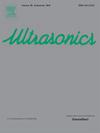Ultrasound scatteromics: A multimodal QUS-based solution for detecting ambulatory function deterioration in Duchenne muscular dystrophy
IF 3.8
2区 物理与天体物理
Q1 ACOUSTICS
引用次数: 0
Abstract
Quantitative ultrasound (QUS) envelope statistics imaging has been investigated as a non-invasive method for evaluating Duchenne muscular dystrophy (DMD). This study introduces an ultrasound scatteromics approach to differentiate between early and late ambulatory stages of DMD. A total of 47 DMD subjects were divided into early (n = 23) and late (n = 24) ambulatory stages. Ultrasound images of the gastrocnemius muscle were acquired and processed to generate multimodal QUS envelope statistics images based on the Nakagami distribution parameter m, homodyned K-distribution parameters α and k, and information entropy H. A simplified feature set based on first-order statistical features of each QUS envelope statistics image was then used for classification with support vector machine (SVM), random forest (RF), and linear discriminant analysis (LDA). A total of 30 iterations of five-fold cross-validation, along with the area under the receiver operating characteristic curve (AUROC), were used for model evaluation. Individual QUS envelope statistics parameters produced average AUROC values below 0.7. Scatteromics achieved average AUROC values of 0.97, 0.98, and 0.83 for SVM, RF, and LDA models, respectively. The simplified scatteromics models, using m, α, k, and H as input to SVM, RF, and LDA, yielded average AUROC values of 0.98, 0.98, and 0.88, respectively. The scatteromics approach outperformed individual QUS envelope statistics imaging methods in monitoring ambulatory function deterioration in DMD in clinical settings (p < 0.05 for AUROC comparisons, DeLong test).
超声散射组学:用于检测杜氏肌营养不良患者运动功能恶化的多模态qbased解决方案
定量超声(QUS)包膜统计成像作为一种无创评估杜氏肌营养不良(DMD)的方法进行了研究。本研究引入超声散射组学方法来区分早期和晚期DMD的动态阶段。47例DMD患者分为早期(n = 23)和晚期(n = 24)两组。基于中川分布参数m、同动k分布参数α和k以及信息熵h,对超声图像进行处理,生成基于一阶统计特征的多模态QUS包络统计图像,并利用支持向量机(SVM)、随机森林(RF)和线性判别分析(LDA)进行分类。共进行30次五重交叉验证,并采用受试者工作特征曲线下面积(AUROC)对模型进行评价。单个QUS包络统计参数产生的平均AUROC值低于0.7。SVM、RF和LDA模型的散射组学平均AUROC值分别为0.97、0.98和0.83。使用m、α、k和H作为SVM、RF和LDA的输入,简化的散射组模型的平均AUROC值分别为0.98、0.98和0.88。在临床监测DMD患者的动态功能恶化方面,散点组学方法优于个体QUS包膜统计成像方法(p <;AUROC比较0.05,DeLong检验)。
本文章由计算机程序翻译,如有差异,请以英文原文为准。
求助全文
约1分钟内获得全文
求助全文
来源期刊

Ultrasonics
医学-核医学
CiteScore
7.60
自引率
19.00%
发文量
186
审稿时长
3.9 months
期刊介绍:
Ultrasonics is the only internationally established journal which covers the entire field of ultrasound research and technology and all its many applications. Ultrasonics contains a variety of sections to keep readers fully informed and up-to-date on the whole spectrum of research and development throughout the world. Ultrasonics publishes papers of exceptional quality and of relevance to both academia and industry. Manuscripts in which ultrasonics is a central issue and not simply an incidental tool or minor issue, are welcomed.
As well as top quality original research papers and review articles by world renowned experts, Ultrasonics also regularly features short communications, a calendar of forthcoming events and special issues dedicated to topical subjects.
 求助内容:
求助内容: 应助结果提醒方式:
应助结果提醒方式:


